SEAFOOD IN JAPAN
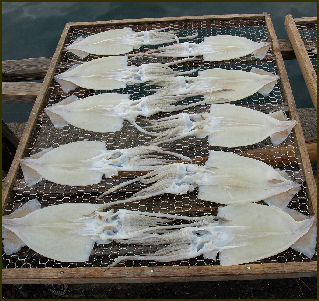
squid drying Top fish consumers (annual consumption per household): 1) Japan, 66 kilograms; 2) China, 56 kilograms; 3) the United States, 47 kilograms; 4) Indonesia, 20.2 kilograms; 5) Russia, 19.1 kilograms. Sixty-six percent of the fish consumed in Japan is domestically caught. [Source: NOAA 2006]
Fish consumption in Japan is declining. Yearly per capita consumption has dropped from around 16 kilograms in 1965 to 13 kilograms in 2005 while the consumption of meat doubled in the same time period from six kilograms to 12 kilograms per person. The consumption of meat is expected to surpass that of fish in the not too distant future.
Fish consumption is dropping because more and more kids dislike it and it is seen as expensive and troublesome to prepare. Also, the number of people who don’t know how to prepare it is increasing. Some Japanese get bad breath from eating katsuobushi dried bonito flakes which they put in rice and rice balls.
In the old days it was mainly people who lived in coastal areas that ate fish. People living in the interior of Japan ate mainly rice and vegetables. In the Nara period (A.D. 710-794) people ate fermented fish. In ancient China and Japan, people salted fish and mixed it rice and left it to ferment, sometimes as long as three years.
The Japanese have traditionally used every part of the fish, including the heads, bones and liver and eaten fish raw, dried, fried, steamed and boiled. People used to buy their fish from fishmonger, which were located on almost every block. Taxes and high land prices drove many fishmongers out of business. These day most people buy fish at the supermarket.
Links in this Website: SUSHI Factsanddetails.com/Japan ; FUGU (BLOWFISH) IN JAPAN Factsanddetails.com/Japan ; RESTAURANTS AND FAST FOOD IN JAPAN Factsanddetails.com/Japan ; DIET AND EATING HABITS IN JAPAN Factsanddetails.com/Japan ;JAPANESE FOODS AND DISHES Factsanddetails.com/Japan
Good Websites and Sources: Good Photos at Japan-Photo Archive japan-photo.de ; Uni (Sea urchin) sushifaq.com ; Unagi (Eel) bento.com ; Sustainable Seafood gourmet.com/foodpolitics ;Japanese Diet and Nutrition Diets of the World “ Japan webmd.com/diet/features/diets-of-world-japanese-diet ; Surprising Facts westonaprice.org/Inside-Japan ; Food and Longevity emaxhealth.com ; Fish and Rice in the Japanese Diet japanreview.net
Sushi Sites: Sushi and Sashimi, Jewels of Japanese Cuisine rgmjapan.tripod.com/SUSHIINTRO ; Sushi Encyclopedism homepage3.nifty.com ; Sushi Etiquette homepage3.nifty.com ;Sushi World Guide (a global list of over 4,700 restaurants) sushi.infogate.de ; Sueyoshi’s Page on Fish (mostly in Japanese) coara.or.jp/~sueyoshi ; Sushi Otaku sushifaq.com/sushiotaku ; Sashimi Glossary rain.org/~hutch/sashimi ; Sushifaq.com sushifaq.com ; Sushi Links sushilinks.com ; Digital Sushi creativeadornments.com/sushi
Exotic Japanese Seafood Dishes
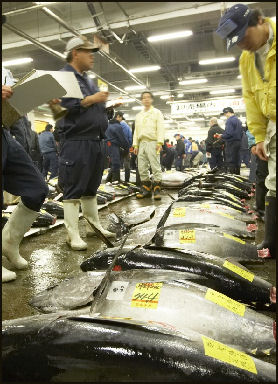
Tsukiji Among the more exotic seafood specialties you can buy at a large Japanese fish market are sea slug caviar ($473 a pound), spicy fish sausage, Okinawan blowfish, persimmon-leaf sushi, fish loaf, dried clam necks, and fried lionfish. Westerners have a hard time stomaching “namako” (sea slug) and “kusaya” (dried horse mackerel). Ankimo (monkfish live mousse) is sometimes called “foie gras of the sea.”
In Kagoshima, it is considered good lick to include a piece of moray eel in a bento school box during a school festival. Along the Pacific coast in Ibaraki Prefecture, people love nabe (stew) made with anglerfish, a grotesque fish that lives at great depths in the sea and has a frog-like face and dorsal spine growing from its head. It is said the meat doesn’t have much flavor but the liver when mixed with miso produces an ideal base for nabe.
Some seafood restaurants serves “apapa” (oysters cooked live on grill that go "apapa" when they pop open); soup made with live eel-like dojo fish that burrow into the floating tofu to unsuccessfully escape the from heat when the soup is cooked; and spider-size baby crabs that are eaten whole. In some restaurants around Kochi Shikoku, octopuses are pulled out of a tank, tentacles are chopped off and eaten and the octopus is thrown back into the tank so its tentacles will grow back. Japanese eat shrimp while it is still alive and wiggling around.
One style of sashimi is served on a plate with the head and body of this fish from which it came. Describing the most unusual aspect of this dish, Jacob Adelmen wrote un the Japan Times, "The fish moved...We all saw it open its mouth and spread its gills in a vain attempt to breath. In unison, the foreigners shrieked and recoiled in shock...The fish lived for another 10 minutes, twitching at intervals, sometimes gasping for air, sometimes merely shaking its fins.”
Seafood Diet in Japan
Japanese love fish and seafood. There are baseball teams (the Hiroshima Carp) named after fish. Whale and other sea creatures pictured are on All Nippon Airlines planes. Toys and television shows have fish and seafood themes. Seafood has traditionally been the main protein source for the Japanese. Japanese get an average of 190 calories a day from seafood products while American gets 29 calories.. Tempura is a favorite Japanese dish. that often features seafood The idea of deep-frying foods in a batter was introduced by the Portuguese and adapted to Japanese tastes. Today tempura is usually shrimp, pieces of fish and various kinds of vegetables deep fired in a fluffy, non-greasy batter.
The Japanese have traditionally eaten a lot of fish. In 2000, the American Heart Association recommended that people eat salmon or tuna twice a week. It was the first time the group recommended eating specific things rather than offering general guidelines. Studies have shown that eating oily fish can significantly reduce the chances of getting a stroke, developing prostrate or breast cancer, suffering from depression or being stricken by a sudden, unexpected death caused by a severely abnormal heart rhythms.
Eating fish has been linked with low cholesterol levels and low rates of heart disease. Oily fish such as salmon and tuna are in rich fish oils, which in turn are rich in omega-3 fatty acids, an essential nutrient in the human diet. There is evidence that omega-3 fatty acids prevent inflammation, clot formation and clogging of blood vessels with fat and cholesterol and that a lack of omega-3 fatty acids may play a role in a variety of maladies, including bipolar disorder, heat arrhythmia, high blood pressure, heart disease, kidney failure, irritable bowel syndrome and rhomboid arthritis.
See Separate Article BENEFITS OF EATING FISH AND CHOOSING THE BEST FISH TO EAT ioa.factsanddetails.com
Fish Consumption in Japan

squid spinning machine Japanese traditionally ate certain fish in certain seasons: bonito and skipjack (“ katsuo”) in the spring; squid (“ ika” ) in the summer; saury (“ sanma” ) in the autumn and amberjack or yellowtail (“ buri” ) in the winter. Salmon used to be a New Year treat eaten mostly in northern Japan and bluefin tuna was a early winter fish eaten when the fish caught in waters off Japan when they were fattened up for the winter.
Now Japanese and other people around the world can get almost any species of fish they want any time of the year. Fish farms in Norway, Chile and other places supply salmon throughout the year and air freight brings in tuna from the Atlantic and the South Pacific when the fish are not plentiful in Japanese waters.
A typical large supermarket sells 32 varieties of fish — whole, dressed, sliced ad semi-dried. Fish flakes are a common ingredient for number of dishes. Popular fish products include boiled fish paste, tubular rolls of fish pate and fish sausage. A government survey found that most popular seafood among children was sashimi and the least popular was boiled fish.
Global demand for fish caused in part by the popularity of sushi and Japanese food around the world is causing overfishing and shrinking fish stocks and coming back to haunt Japan as non-Japanese outbid Japanese for supplies of fish on the global market. These days the best quality bluefin tuna is just as likely to end up in New York, Shanghai or even Moscow as it is in Tokyo.
To be a good environmentally-friendly fish consumer, one is advised to eat species of fish when they are in season — or in other words when there is an abundance of them — and eating fish at the bottom of the food chain.
See Economics, Agriculture and Fishing
Types of Fish and Seafood Eaten in Japan
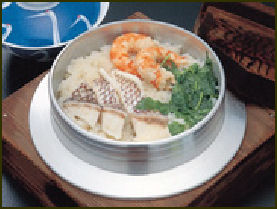
tai Squid is one of the most popular seafood in Japan, along with tuna and salmon. The secret to tasty squid is keeping captured squid in water in which they were caught which keeps them from getting stressed out. When transported they are put in special tanks and cooled to near freezing temperatures.
“Tai” (sea bream) is traditionally served at weddings and New Year’s and other happy occasions and is given the Japanese Emperor as a gift and to sumo wrestlers when they win a tournament. The proverb “kusatte mo tai” (“even if its spoiled its sea bream”) means that sea bream is always special. The whole tai fish means everything is present and symbolizes the completeness of life. The word “tai” is considered auspicious it has the same last syllable as the word “ omedetai “ (“good luck”). The traditional way of cooking tai is to grill it with salt. Some chef like to cove the fish completely with a layer of salt and bake it in foil.
Japanese love clams. “Hamiguri” are large clams prepared on a special small grill that cooks one clam at a time. The clams pop open when they are ready and often featured in beer ads with people having a good time. The Japanese also love oysters. One of the first places that many Japanese seek out during trips to the United States is a restaurant with a oyster bar that offers raw oysters. A Japanese man who died at the age of 96 said he owed his long life to the fact he swallowed two oysters every morning.
About 70 percent of all the domestic clams consumed in Japan come from waters off Kashima in Ibaraki and Chiba Prefectures. The clams there are collected by three associations divided into five groups, with only one group allowed to gather clams at one time with a period of at least one week between the time the next group can depart. It is said clams are tastiest in the winter and spring when they put in fat before starting to lay eggs in June.
Surimi is a Japanese term used to describe deboned fish washed with water. Usually sold as fake crab, it is made from a variety of fish, including Alaskan pollack, Pacific whiting, cod and arrowtooth flounder. “Hirame” are costlier flatfish with eye son the left side of their body while “karei” are cheaper flatfish with eyes on the right side of their body.
“ Shirasu”, or whitebait, is another fixture of Japanese cuisine. It refers to the fry of Japanese anchovy, actually a kind a sardine, and two other kinds of sardine fry. Raw shirasu is eaten as sushi and dried shirasu is place on white race or added to ther dishes as a flavoring. The fish are caught in great abundance in March and April in waters off Kamakura, Kanagawa Prefecture.
Shark is generally avoided because of its strong smell. A research center in Chiba produces dried shark snacks that use large amounts of miso and soy sauce to kill the strong shark meat aroma.
Japanese are fond of fish sausage. The packages are sealed with metal ring. Sometimes people complain of cutting their lip and chipping the teeth when they try to remove the ring.
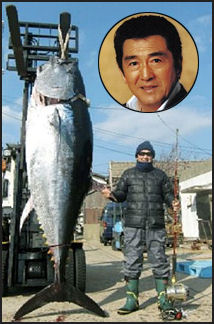
big bluefin Aji horse mackerel — usually locally caught — has traditionally been the favorite fish in Japan. In 1965 it was the most popular fish, followed by squid and mackerel. In 2009, salmon became the No.1 fish in Japan, followed by squid and tuna. The change has been attributed to advances in freezing technology, salmon’s low cost and year-year availability and the ease in which salmon can be prepared
Dried “ aji “ is a popular treat in Japan. After the fish are caught they are sliced open, gutted, soaked in a sea salt solution and dried in the sun. About half of the country’s dried aji is produced in Numazu in Shizuoka Prefecture. The delicacy from there is said to be particularly tasty because it is produced using mineral-rich subsoil water from Mt. Fuji. Drying is done in accordance with the weather and wind direction on each particular day.
“ Hoshi Kuchiko “ is a delicacy made by drying salted namako (sea cucumber) ovaries for about two weeks in the sun. A specialty of the Noto district of Nanao in Ishikawa Prefecture, it is produced in late winter and is said to go well with sake.
Tuna in Japan
Japan leads the world in tuna consumption. It consumes one third of the world’s tuna production and 95 percent of the world’s toro. The United States consumes roughly another third. In 2003, about 458,000 tons of raw tuna was sold in Japan. Of this, 43 percent was caught in Japanese waters. The rest was imported. The consumption of raw tuna peaked in the early 1990s at around 528,000 tons.
Yellowfin tuna is widely consumed in Japan in sashimi and sushi. Around 20,000 to 38,000 tons of the annual catch of 100,000 to 150,000 tons of the fish caught in central and western pacific is consumed in Japan. Because overfishing of the fish is regarded as a serious problem fishing experts have called for a 30 percent reduction of the yellowfin tuna catch,
See Separate Articles: BLUEFIN TUNA: CHARACTERISTICS, BEHAVIOR, HUNTING AND MATING ioa.factsanddetails.com ; BLUEFIN TUNA SPECIES: ONE IN THE PACIFIC, ONE IN THE SOUTH, TWO IN THE ATLANTIC ioa.factsanddetails.com ; BLUEFIN TUNA COMMERCIAL FISHING ioa.factsanddetails.com ; BLUEFIN TUNA AND SUSHI ioa.factsanddetails.com ; BLUEFIN TUNA FISH FARMING ioa.factsanddetails.com ; LOW BLUEFIN TUNA NUMBERS: OVERFISHING, ORGANIZATIONS, QUOTAS AND PROTESTS ioa.factsanddetails.com
Salmon in Japan
Salmon sushi is very popular. It is often served with mayonnaise and onions top. Salmon breeds in rivers in northern Niigata Prefecture, the Tohuku region and Hokkaido. The fish from the Murakami area of Niigata is regarded as the best. Many sushi chefs say that male salmon tastes better than females.
The Japanese word “ikura” (“salmon eggs”) comes the Russian word “ikrra” (“cavair”). Ikuri sushi is a favorite with Japanese children.
The Toyama and Niigata areas are famous for wind-dried salmon. In a process called “kanboshi”, the salmon in Toyama is tied to ropes and hung and dried by harsh cold winds that blow out of the Tateyama mountains that reportedly draw fat out of the fish. One producer told the Yomiuri Shimbun, "Whether we make a good dried salmon or not depends on how much fat we can press out of the fish bellies."
In Niigata salmon is dried in a similar fashion except the fish are cut open like a harakiri disembowelment. “Shiobiki-zake” (“ salmon dried naturally by the air”) is seasonal delicacy produced n Murakami, Niigata Prefecture by hanging the salmon from the eaves of houses for several days after being salted and having their belly cut open.
A speciality of Murakami is sake no “sakebitashi”, or -sake marinated salmon. It is made with salted salmon that is hung upside down and dried for a year and allowed to ferment. The meat is then cut into pieces and pickled in sake. The delicacy is popular with gourmets all over the world, particularly in Germany.
Anglerfish

anglerfish “Anko”, or anglerfish, is an ugly-looking fish, that is prized as an ingredient in “nabe” stews, particularly in eastern Japan. Hirakata, a port north of Tokyo in Ibaraki Prefecture, is regarded as the center of anko fishing. In the waters off the town, where the Oyoshio and Kuroshio currents collide, there are abundant supplies of small fish for the large-mouthed anglerfish to eat.
There are about 300 known species of anglerfish, some of which are among the deepest-dwelling ocean fish. Those prized in Japan as food include “kianko”, a yellow goosefish species, prized for its liver, and “ankimo”, known as foie grass of the sea. When kianko are put up for auction they displayed upside-down so buyers can check out their livers.
Among the first people to embrace anglerfish as a food were Japanese fishermen who ate it at sea, where fresh water is in short supply, because anglerfish could be prepared without water as 80 percent of the fish’s body is water. Later the dish caught on with locals in fishing villages and then among tourists. One of the most popular anko dishes is “dobu-jiru”, which is made using all parts of the fish’skin, fins, ovaries, stomach, gills, liver — and uses only miso and dry-fried liver as seasoning.
Anglerfish are often cut outside while hanging from a hook. Their bodies are covered in mucous membranes called “noro”, which make the fish difficult to slice on a cutting board. When cooked as nabe the dish takes on an orange color as a result of orange fat oozing from the liver.
See Separate Article ANGLERFISH: CHARACTERISTICS, UNUSUAL MATING AND JAPANESE FOOD ioa.factsanddetails.com
Saury and Bonito in Japan
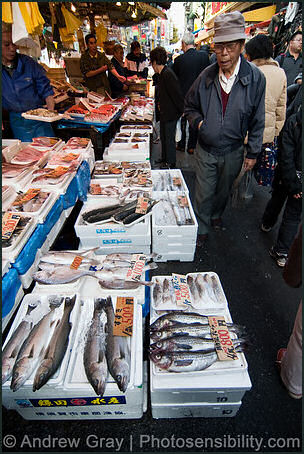
fish market Saury, or mackerel pike, is a popular fish in Japan. Associated with autumn and preferably consumed fresh, it is salted and grilled and is said to be best in late September and October when their fat content rise to 20 percent. The aroma of grilling saury is a common smell when walking by Japanese homes around dinner time.
Saury fat contains fish oils that prevent high blood pressure and stiffening of the arteries. The internal organs contain substance that help blood and bone production. Saury are often eaten whole: flesh, bones and internal organs. Saury is best eaten very fresh because they internal organs quickly obtain a bitter flavor if left unprepared. A fresh saury is firm enough to stand erect when held vertically and has translucent eyes when cooked.
Bonito has different names depending on when it is caught. Those caught in the spring are called “hatsu-gatsuo”. Those caught in the autumn are called “modori-katsuo”. The former are light tasting and have relatively little fat. The latter has up to 10 times more fat and a much richer taste. In the summer the fish are found in a nutrient-rich area where two currents collide and get fattened up for the autumn.
“ Katsuo-bushi” (dried and smoked bonito) is a key ingredient to Japanese cuisine. Usually sold as flakes shaved from the fish, it has a brownish-pink color and a distinctive smokey, fishy smell and finds it way into a lot popular foods such as miso soup and rice balls and is sprinkled on top of okonomiyakli pancakes and white rice for extra flavoring.
Ancient historical records published in A.D. 712 refer to “ katauo “ (“bonito”) as the “stiff fish” and describe it being dried in the sun. In the samurai ere bonito was roasted and fried for armies to take into battle. A description of katsuo-bushi can be found in a food encyclopedia published in 1697.
See Separate Articles: SKIPJACK TUNA AND BONITO ioa.factsanddetails.com
Eel in Japan
One of the most poplar summer dishes in Japan is “unagi” (barbecued sea eel) served over steaming rice or as sushi with a delicious sweet brown sauce. "Grilled eel" wrote Reid, "has long been considered a luxury meal in Japan. It has a consistency similar to fried fish and tastes something like barbecued chicken. “ Unagi is believed to be ward off the summer heat. It is commonly eat en masse on July 25, mid-summer according to the traditional Japanese calendar.
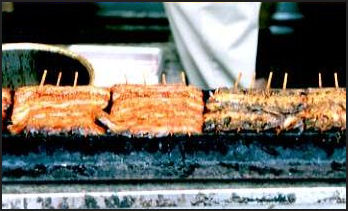
grilling unagi "The idea of eating “unagi” as way to cool off was a promotional gimmick dreamed up by the national association of unagi restaurants," Reid wrote. "The marketing strategy has worked. On hot summer days people wait in long lines to get inside unagi restaurants and the biggest eel-eating day of the year...It hardly seems like a way to beat the heat, but the eel industry here has successfully sold the serpentine specimen as a high-protein meal that provides stamina in muggy weather." When Reid asked one salaryman why he was eating eel, he answered, 'I need strength to deal with this oppressive heat. Everybody knows that eel makes you strong in summer."
Eel is supposed to be an aphrodisiac. It is supposed to be especially portent if served with a phallic shaped plum. Lake Hamana, near Nagoya, is famous for eel production. Towns around the lake sell eel pie made with powdered dried eels and garlic. Eels are a popular food in Britain, where they are made into pies served at pubs.
About 100,000 tons of eels is consumed in Japan each year. This is about 70 percent of the worldwide eel production.
See Separate Article EELS: MIGRATION, JAPAN, UNAGI, BIG MONEY ioa.factsanddetails.com
Octopus Dumplings
Japan boasts the world's highest level of octopus consumption, with Japanese consuming 60 percent of the world's catch.
Takoyaki (gooey dumplings made with octopus legs) is a snack associated with the Osaka area. The golf-ball-sized, gooey, balls are made on special pitted grittles in stands along the sidewalks. They are extremely hot with fish flakes and a sweet brown sauce. The octopus is chewy, the outside is soft and the inside is gooey
Reporting from Akashi near Kobe, Yasushi Wada wrote in the Yomiuri Shimbun, “To overcome the summer's enervating heat, Kansai folk have a recipe--serve up octopus. So popular is the belief in the Kansai region that consuming octopus is effective in relieving fatigue that July 2 unofficially has been named Day of the Octopus.” [Source: Yasushi Wada, Yomiuri Shimbun, July 2, 2010]
"Octopus can be caught throughout most of the year off Akashi, but it tastes best from July to the Bon season in August," said Yosuke Maeda, an employee of the Akashiura fisheries cooperatives. "In summer, shrimps and crabs, the favorite foods of octopuses, are abundant. So octopuses caught around this time are most delicious. "The current is strong in this area, which makes octopuses chewy and tastier."
“The city's specialty is egg dumplings, better known as Akashiyaki outside the city,” Wada wrote. “Whereas the better-known takoyaki dumplings are typically filled with octopus, vegetables and tempura scraps, Akashiyaki dumplings contain only octopus. Another difference is that takoyaki are consumed with a savory sweet sauce, while Akashiyaki dumplings are dipped in a dashi broth made from kombu (dried kelp) and katsuobushi (dried bonito flakes)...Unlike takoyaki with its heavily seasoned flavor, Akashiyaki dumplings have a simple taste, making the flavor of the octopus stand out.
Red Queen Crabs
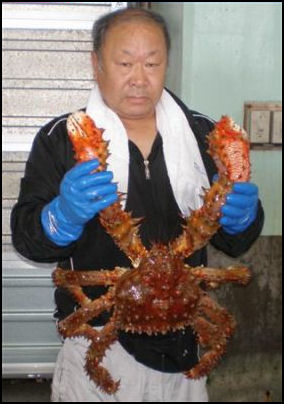
Bright red beni-zuwaigani, or red queen crabs, unlike their cousins the zuwaigani, or snow crabs, have a red shell even before they hit the cooking pot. Red queen crabs are mainly caught in the Sea of Japan and live at depths of 500 meters to 2,000 meters. Every year, fishermen bring in 20,000 tons — about four times the annual snow crab haul — of beni-zuwaigani. The larger catch means cheaper prices: A single red queen crab costs from one-fifth to one-eighth as much as a snow crab. This makes red queens the preferred variety for prepared dishes, such as gratins and croquettes.” [Source: Yasushi Wada, Yomiuri Shimbun, December 6, 2010]
"Toyama Bay gets really deep right off the coast, so the processing plant is very close to the red queen's habitat," Kazuhisa Hagiwara of the Shinminato fishery cooperatives told the Yomiuri Shimbun . "We go out fishing at night and come back in the morning. By noon the catch is already on the block. That's why the crabs are so fresh.” The peak of the red queen season is from December to around February. “We bring in so many crabs the market almost can't handle it,"
Yasushi Wada wrote in the Yomiuri Shimbun, “Nearby seafood shop Yasuyoshi Suisan was boiling up a huge pot of fresh red queen crabs that had been purchased just 20 minutes earlier at the market's auction. I tried some meat that had been cooked properly and some that had been in the pot for a half-hour." Five minutes is enough for crab meat, but we boil the shells for 30 minutes so the kanimiso [edible innards] aren't runny. Only five minutes for the meat, though. It tastes better that way," said Yoshio Yasuyoshi, the shop's owner. Yasuyoshi was right: The red queens that had been boiled only a short time had richer flavor and tasted better, almost as good as fresh boiled snow crabs.
Jellyfish and Sea Urchins in Japan
In China, Korea and Japan people enjoy eating jellyfish, which is salted and dried, and has had the stingers removed. In Japan jellyfish is usually served in a sweet, vinegary sauce and other tastes bland and has a rubbery texture. It is also considered a treatment for bronchitis and high blood pressure.
Uni (sea urchin meat) is a popular delicacy in Japan. It is soft, buttery and yellow, red or bright orange in color. To eat it you break open the shell and pick out the sexual organs with your chop stick, dip it in some soy sauce and swallow. In uni-producing areas it is often served in a bowl of rice.
Store-bought uni melts in the mouth. Fresh uni is firm and the texture of each tiny egg can be felt. Uni is best eaten in the summer when the sea creatures fatten themselves up before spawning in the autumn. The best quality stuff is preserved in salt water and is often served with seafood jelly
There are 10 uni-producing region in Japan. The uni from each region being a little different. The west coast of Hokkaido is the main uni-producing area in Japan. Much of the sea urchin sold in Japan comes from California, Oregon and Maine. Sea urchin supplies have been so badly depleted in Japan that uni fishermen are only allowed to fish in Japanese waters two hours a day.
Some domestically-produced sea urchin comes from Miyagi Prefecture. Some measure 15 centimeters across and are said to be at their best when they are harvested in June. Boats set out at 5:00am and fishermen search for the sea creatures using wooden boxes with glass bottoms, Fishermen use poles, which have hook on the front edge, to pick up and drop sea urchins in a basket under the water. The uni harvesting season lasts from June to August.
Herring Roe
In a custom that has been described as deeply rooted in Japanese culture as the eating of turkey on Thanksgiving in America, millions of Japanese consume “kazunoko”, or herring row as part of their New Year's celebration. "The thick clusters of tiny golden eggs found in the female fish when they are ready to spawn," wrote Jon Krakauer in Smithsonian magazine, "are marinated in sweet sake and soy sauce and then served uncooked as sushi, artfully arranged with seaweed and a dollop of rice on a special ceremonial plate." [Source: Jon Krakauer, Smithsonian, October 1986]
Eating kazunoko, which is supposed to increase fertility, has been compared to "chewing on salty rubber BB's." Sometimes referred to as "yellow diamond," the finger-length sacs of roe sell for a $100 a pound or more. Since the fish have been fished to extinction in Japanese waters, demand is met with an estimated annual catch of one billion Pacific herring caught along the North American coast, mostly off of Alaska and British Columbia.
The scientific name for herring, “Clupea harengus”, is derived from an old German term meaning "army." This silvery fish form schools that can stretch for miles and include hundreds of millions of fish.
Harvesting Herring Roe, see Fishing
Whale Meat in Japan

minke whale bruger at
Hakodate restuarant
in Hokkaido Many Japanese, especially older and middle-ages ones, consider whale meat to be a delicacy. It is sauteed, roasted and eaten raw. Japanese say it tastes more like beef than fish. Whale bacon sells for as much as $180 a pound at gourmet food shops and dishes made with whale go for as much as $100 a plate at restaurants.
Whale meat is dark red and doesn't look at like fish meat. Japanese consider blue, fin and sei whales to be the tastiest. Sperm whales aren't regarded as very tasty. Humpback meat isn't considered that good but the organs are palatable. Japanese generally like minke whales less than other species because they are small and don't contain much fat, which is what the Japanese lovr. Before the 1987 ban on whaling the Japanese didn't even hunt them.
Whale meat in Japan has traditionally made into stews with soy sauce and spinach. These stews are now made with beef or pork. In the whaling town of Wadamachi in Chiba you can gey whale steaks, whale jerky, carved whale-tooth jewelry and even a one-meter-long decorated whale penis. Some towns sell whale nose cartilage pickled in sake in cans with a spouting whale. Those who have tried it said the cartilage has a crispy texture and a pungent taste.
See Separate Article WHALES AND WHALE MEAT DISHES AND CONSUMPTION IN JAPAN factsanddetails.com
Image Sources: 1) 2) Ray Kinnane, 3) 4) 5) JNTO, 6) 9) Japan Zone 7) Andrew Gray Photosensibility 8) Hector Garcia, 10) Jun at Goods from Japan, 11) 13) Shimonoseki site 12) BBC, 14) xorsyst blog
Text Sources: New York Times, Washington Post, Los Angeles Times, Daily Yomiuri, Times of London, Japan National Tourist Organization (JNTO), National Geographic, The New Yorker, Time, Newsweek, Reuters, AP, Lonely Planet Guides, Compton’s Encyclopedia and various books and other publications.
Last updated April 2023
